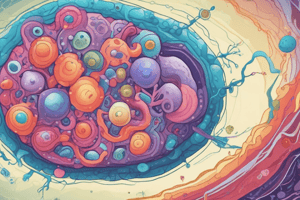Podcast
Questions and Answers
Describe 5 main differences between prokaryotes and eukaryotes.
Describe 5 main differences between prokaryotes and eukaryotes.
Describe 5 main differences between prokaryotes and eukaryotes:
Describe 5 main differences between prokaryotes and eukaryotes:
- One circular chromosome, not in a membrane; 2. No histone; 3. No organelles; 4. Bacteria: peptidoglycan cell walls; 5. Binary fission.
What are the main features of a eukaryote?
What are the main features of a eukaryote?
- Paired chromosomes in nuclear membrane; 2. Histones; 3. Organelles; 4. Polysaccharide cell walls; 5. Mitosis & meiosis.
Identify 3 main shapes of bacteria:
Identify 3 main shapes of bacteria:
List 5 structural features that are common to all bacteria:
List 5 structural features that are common to all bacteria:
Briefly summarize the structure and function of the glycocalyx:
Briefly summarize the structure and function of the glycocalyx:
What is the function of the glycocalyx?
What is the function of the glycocalyx?
What is the concept of gram staining in relation to peptidoglycan layers in bacterial cell walls?
What is the concept of gram staining in relation to peptidoglycan layers in bacterial cell walls?
Compare common transport processes in prokaryotes:
Compare common transport processes in prokaryotes:
Contrast group translocation with phagocytosis:
Contrast group translocation with phagocytosis:
Differentiate between a DNA bacterial chromosome and a DNA bacterial plasmid:
Differentiate between a DNA bacterial chromosome and a DNA bacterial plasmid:
What is the benefit of endospore formation in bacteria?
What is the benefit of endospore formation in bacteria?
Describe ribosome subunits of mitochondria and compare to a bacterium:
Describe ribosome subunits of mitochondria and compare to a bacterium:
Compose an argument for the observed toxicity of streptomycin on the liver:
Compose an argument for the observed toxicity of streptomycin on the liver:
Hypothesize why streptomycin antibiotics are lethal to Mycoplasma when penicillin antibiotics are not:
Hypothesize why streptomycin antibiotics are lethal to Mycoplasma when penicillin antibiotics are not:
What items are of more relevance and likely to be tested?
What items are of more relevance and likely to be tested?
Study Notes
Differences Between Prokaryotes and Eukaryotes
- Prokaryotes have one circular chromosome, while eukaryotes possess paired chromosomes within a nuclear membrane.
- Prokaryotes lack histones, whereas eukaryotes contain histones associated with their DNA.
- Prokaryotes do not have organelles; in contrast, eukaryotes have various membrane-bound organelles.
- Bacteria (prokaryotes) have cell walls made of peptidoglycan, while eukaryotic cell walls are typically composed of polysaccharides.
- Prokaryotic reproduction occurs through binary fission, while eukaryotes reproduce via mitosis and meiosis.
Shapes of Bacteria
- The three primary shapes of bacteria are coccus (spherical), bacillus (rod-shaped), and spiral (twisted).
Structural Features Common to All Bacteria
- All bacteria consist of cytoplasm and contain 70S ribosomes.
- Each bacterium has a plasma membrane and a cell wall.
- Bacteria have a nucleoid region that contains their DNA.
Glycocalyx Structure and Function
- Glycocalyx is typically sticky; it can form a capsule that is neatly organized or a slime layer that is loose and unorganized.
- It is located outside the cell wall and consists of polysaccharides, polypeptides, or both, aiding in attachment and protecting cells from phagocytosis.
- Glycocalyx plays a critical role in biofilms by facilitating communication, protecting against dehydration, and anchoring cells to surfaces.
Gram Staining and Cell Wall Layers
- In gram staining, crystal violet-iodine crystals form in gram-positive bacteria, where alcohol dehydrates peptidoglycan, trapping the crystals.
- In gram-negative bacteria, alcohol dissolves the outer membrane, allowing the crystals to wash out, which can then be stained with a counterstain like safranin.
Transport Processes in Prokaryotes
- Prokaryotes utilize a non-specific transporter unique to them, distinct from processes like simple diffusion or facilitated diffusion that involve concentration gradients to move substances across membranes.
Group Translocation vs. Phagocytosis
- Group translocation is a process exclusive to prokaryotes that modifies substrates during transport, while eukaryotic phagocytosis involves engulfing solid particles to be digested.
DNA Bacterial Chromosome vs. Plasmid
- Bacterial chromosomes contain essential genes and are typically circular, while plasmids are smaller, autonomous DNA molecules that can carry additional genes, often providing advantages like antibiotic resistance.
Benefits of Endospore Formation
- Endospore formation is initiated in adverse conditions, offering protection against extreme environments. Structural features that contribute to the endospore's resilience include a thick protective coat, a dehydrated core, and resistance to heat and chemicals.
Ribosome Subunits Comparison
- Mitochondria possess ribosomes that are similar to bacterial ribosomes (70S), supporting the endosymbiont theory, which posits that mitochondria evolved from ancestral prokaryotic cells.
Toxicity of Streptomycin on the Liver
- An argument for the observed toxicity of streptomycin on the liver could relate to its interaction with prokaryotic ribosomes, potentially causing adverse effects on human liver cells that may share similar mechanisms or pathways.
Streptomycin vs. Penicillin Effects on Mycoplasma
- Streptomycin is lethal to Mycoplasma bacteria due to its targeting of ribosomal activity, whereas penicillin, which targets cell wall synthesis, is ineffective since Mycoplasma lack a cell wall.
Studying That Suits You
Use AI to generate personalized quizzes and flashcards to suit your learning preferences.
Description
Test your understanding of the key differences between prokaryotes and eukaryotes in this objective flashcard quiz. Learn about their structures, reproduction methods, and cellular components. Perfect for students studying microbiology concepts!




